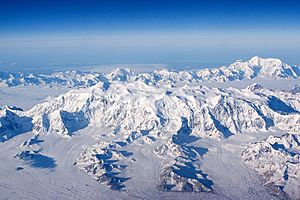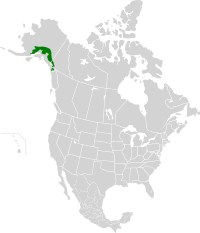Alaska–St. Elias Range tundra facts for kids
Quick facts for kids Alaska-St. Elias Range tundra |
|
|---|---|

The Saint Elias Mountains - Mt Logan with Mount Saint Elias in the background
|
|

Alaska/St. Elias Range tundra
|
|
| Ecology | |
| Realm | Nearctic |
| Biome | Tundra |
| Borders |
List
|
| Geography | |
| Area | 151,800 km2 (58,600 sq mi) |
| Country | Canada and United States |
| States/Provinces | Alaska, British Columbia, and Yukon |
| Geology | Rocky slopes, icefields, and glaciers |
| Conservation | |
| Conservation status | Relatively Stable/Intact |
The Alaska–St. Elias Range tundra is a special natural area, or ecoregion, found in northwestern North America. It's a vast land of towering mountains, huge glaciers, and unique plants and animals.
Contents
What is the Alaska-St. Elias Range Tundra Like?
This ecoregion is a long chain of tall, rocky mountains. It stretches from the bottom of the Alaska Peninsula in the United States, through the Alaska Range, and then south to include the Wrangell Mountains and Saint Elias Mountains. These mountains also cross into the southwestern part of the Yukon and northwestern British Columbia in Canada.
Most of these mountains are covered in ice and snow all year round. Above about 2,150 meters (7,050 feet), you'll find permanent snow. The valleys between the peaks are filled with massive ice fields and giant glaciers. Some parts are not covered by ice; these areas have rocks, rubble, and a type of cold grassland called alpine tundra.
The land here ranges from sea level on the western coast to over 4,000 meters (13,000 feet) at the mountain tops. Denali (also known as Mount McKinley), the highest peak in North America, stands tall here at 6,100 meters (20,000 feet)! The St. Elias Mountains also reach heights of up to 6,000 meters (19,700 feet), making them some of Canada's tallest mountains.
Because this ecoregion is mostly separated from the coast by other mountain ranges, it has a "continental" climate. This means it has colder winters and warmer summers than coastal areas. The amount of rain and snow varies, from about 200 mm (8 inches) per year on the higher slopes to 400 mm (16 inches) per year in the lower areas.
Plants of the Tundra
On the higher mountain slopes, the ground is often frozen all the time. This is called permafrost. Despite the cold, some tough plants grow in the patches not covered by ice. These plants are part of the alpine tundra. You might find beautiful mountain avens (Dryas octopetala) and different kinds of Erica plants. Examples include Vaccinium vitis-idaea (also known as lingonberry) and Cassiope tetragona (Arctic white heather). These plants are specially adapted to survive in cold, windy conditions.
Animals of the Tundra
This ecoregion is home to many amazing animals. Large brown bears roam areas like Denali National Park and Preserve and the southwestern coast near Iliamna Lake. Other mammals you might see include mountain goats, caribou, moose, and Dall sheep. Smaller animals like North American beavers and snowshoe hares also live here. The rivers flowing through this area are important homes for different types of salmon.
Many birds also live in the Alaska-St. Elias Range tundra. Some common birds include the willow grouse, Siberian tit, wheatear, Wilson's warbler, and boreal chickadee. These birds are adapted to the cold climate and often migrate to warmer places for winter.
Protecting This Special Place
The Alaska-St. Elias Range tundra is mostly untouched by human development. This makes it a great home for large predators and other wildlife. However, there is some tourism, especially near Denali National Park, and a bit of mining. For example, there's an old copper mining camp called Kennecott, Alaska in the Wrangell Mountains.
Luckily, many parts of this ecoregion are protected. These protected areas help keep the environment healthy for plants and animals. Some of these important places include:
- Lake Clark National Park and Preserve
- Denali National Park
- Denali State Park
- Tetlin National Wildlife Refuge
- Wrangell-St. Elias Park and Preserve
All of these are in Alaska. In Canada, parts of Tatshenshini-Alsek Provincial Park and Kluane National Park and Reserve also protect this unique ecoregion. These parks and refuges ensure that this beautiful and wild landscape remains safe for future generations.
See also
 In Spanish: Tundra de Alaska-St. Rango Elias para niños
In Spanish: Tundra de Alaska-St. Rango Elias para niños

